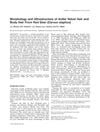TLDR Human hair has a complex, variable structure with a consistent matrix and double-twist pattern.
The study investigated the three-dimensional architecture of macrofibrils in the human scalp hair cortex, revealing that human hair macrofibrils have a consistent matrix fraction and typically exhibit a double-twist architecture. Unlike wool, human hair showed significant inter-macrofibril variation in the incremental angle increase between intermediate filaments (IFs), with a negative correlation between macrofibril size and IF increment. This variation was observed across different hair types, including Caucasian, Japanese, and African, indicating a common feature in human hair. The findings advanced the understanding of the nano-level and cell-level organization of human hair, highlighting the complexity and variability of macrofibril architecture compared to wool.
29 citations
,
April 2011 in “Journal of Microscopy” The modified osmium method improves hair cortex staining for better visualization.
 18 citations
,
November 2010 in “Journal of morphology”
18 citations
,
November 2010 in “Journal of morphology” Antler velvet hair and body hair of red deer have different structures that help with protection and insulation.
62 citations
,
December 2008 in “Journal of structural biology” Hair curvature in Japanese people is linked to specific cell types and filament arrangements in the hair cortex.
85 citations
,
October 2007 in “International Journal of Dermatology” Curly hair shape is due to uneven growth patterns in the hair follicle.
70 citations
,
February 2007 in “Journal of Investigative Dermatology” K39 and K40 are the last keratins expressed in hair development, completing the hair keratin catalog.
254 citations
,
January 2007 in “Chemical Society Reviews” Hair is a complex protein fiber with unique properties useful for developing hair products.
65 citations
,
May 2006 in “Journal of Structural Biology” Hair curliness is due to uneven distribution of different cortices within the hair fiber.
226 citations
,
January 2006 in “International review of cytology” Keratin-associated proteins are crucial for hair strength and structure.
276 citations
,
January 2005 in “International review of cytology” More research is needed to understand how hair keratins work and their role in hair disorders.
56 citations
,
January 1977
36 citations
,
December 1991 in “Journal of Dermatological Science” Human nails contain both skin and hair keratins, each needing different extraction methods.
